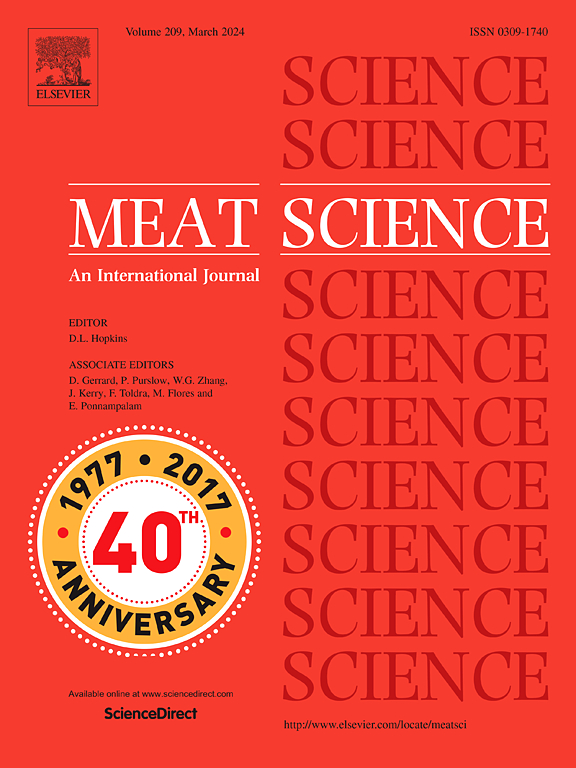Effect of wet and dry post-mortem rabbit loin meat ageing on its physicochemical and sensory properties
IF 6.1
1区 农林科学
Q1 Agricultural and Biological Sciences
引用次数: 0
Abstract
Fifty male 90-day-old Hyplus rabbits (PS19 × PS40) were slaughtered (carcass weight: 2126 ± 316.1 g) to determine the effect of post-mortem ageing methods (wet vs dry) and ageing period (7 or 14 days) on the physicochemical characteristics and sensory properties of the longissimus thoracis et lumborum (LTL) muscle. Of the 50 carcasses, 10 were used for physicochemical meat quality assessment on 24 h post-mortem (D1). The remaining carcasses were assigned to either wet ageing (deboned muscles in vacuum-packaging) or dry ageing (whole carcass), for 7 “D7” or 14 “D14” days (n = 10 per treatment combination). Physicochemical and sensory analyses were performed after each ageing period. Results revealed that wet-aged LTLs were lighter in colour (L*) than the dry-aged LTLs, regardless of the ageing period. The wet-aged samples also had the highest a* values (redness) on D14 than all other treatments. Cooking loss percentages were greater in wet- than dry-aged meat on D14, but did not differ on D1 and D7 of wet ageing. Shear force decreased from D1 to D7 of ageing, regardless of the method used, and then stabilised. The dry-aged meat on D14 exhibited the lowest moisture content and the highest ash content, whilst the greatest malondialdehyde concentration was reported on D7 for dry-aged meat corresponding with its higher scores for off-odour intensity by the sensory panel. Whilst no significant differences were noted for overall acceptance on D7, the positive flavour development during dry ageing after 14 days was favourably evaluated by the panellists.
湿、干死后兔腰肉陈化对其理化及感官性能的影响
选取50只90日龄雄性Hyplus兔(PS19 × PS40)屠宰(胴体重:2126±316.1 g),研究不同的死后老化方式(湿法和干法)和老化时间(7天或14天)对胸腰最长肌(LTL)理化特性和感觉特性的影响。50具胴体中,10具胴体在死后24 h (D1)进行理化肉质评价。其余胴体分别进行湿老化(真空包装去骨肌肉)或干老化(整个胴体),为期7“D7”或14“D14”天(每个处理组合n = 10)。在每个老化期后进行物理化学和感官分析。结果表明,无论龄期如何,湿龄LTLs的颜色都比干龄LTLs浅(L*)。湿老化样品在D14上的a*值(红度)也高于所有其他处理。湿熟肉的蒸煮损失率在第14天大于干熟肉,但在第1天和第7天没有差异。无论采用何种方法,剪切力都从老化的D1下降到D7,然后趋于稳定。D14干熟肉的水分含量最低,灰分含量最高,而D7干熟肉的丙二醛浓度最高,其气味强度在感官面板上得分较高。虽然D7的总体接受度没有显著差异,但专家组成员对14天后干陈酿过程中积极的风味发展进行了积极的评价。
本文章由计算机程序翻译,如有差异,请以英文原文为准。
求助全文
约1分钟内获得全文
求助全文
来源期刊

Meat Science
工程技术-食品科技
CiteScore
12.60
自引率
9.90%
发文量
282
审稿时长
60 days
期刊介绍:
The aim of Meat Science is to serve as a suitable platform for the dissemination of interdisciplinary and international knowledge on all factors influencing the properties of meat. While the journal primarily focuses on the flesh of mammals, contributions related to poultry will be considered if they enhance the overall understanding of the relationship between muscle nature and meat quality post mortem. Additionally, papers on large birds (e.g., emus, ostriches) as well as wild-captured mammals and crocodiles will be welcomed.
 求助内容:
求助内容: 应助结果提醒方式:
应助结果提醒方式:


